Introduction
The orange sulphur butterfly (sometimes called the alfalfa caterpillar) is a common species found in natural and agricultural areas of Nevada and distributed throughout most of North America. It is a fast, erratic flyer, usually seen as a yellow blur flying fast and low across a meadow, rarely stopping to drink nectar at flowers. Though it rarely reaches pest levels, it can be seen in abundance in alfalfa fields. The species is one of many that uses introduced plant species (alfalfa included) as host plants for caterpillars, and in some areas uses mainly nonnative species (Shapiro and Manolis 2007).
Integrated Pest Management
Description and life cycle
Adults
Adult butterflies are bright‐yellow to bright‐orange on the upper side (seen with wings open), with black markings along the wing edges and a reddish‐pink dot on the hind wing. Females usually have thicker markings along the edges of the upper side. The underside (seen with the wings closed) is yellow with a greenish tinge, with a single white spot and a few small blackish‐brown dots along the edge of the hind wing. There is also a “white” form that occurs only in females, where both the upper side and underside are almost entirely white. Antennae and legs are reddish‐pink.
This butterfly species is variable as an adult. In addition to the white form in females, there is considerable size variation, with early‐season adults much smaller than mid‐summer adults. Early‐season individuals may also have less orange on their upper sides. Finally, this species is known to hybridize with the related yellow sulphur (Colias eriphyle), where the ranges overlap, which includes all of Nevada. This hybridization leads to adults with varied color and marking patterns, and the two species cannot always be differentiated.
Drawing by Cynthia Scholl.
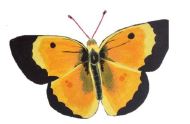
Eggs and caterpillars
Adults females lay football‐shaped eggs that are white at first, turning to yellow and then red. Eggs hatch after four or five days. Newly hatched, first instar caterpillars range from 2 to 4 millimeters in length. As with many butterfly species, first instar caterpillars change colors after feeding. Newly hatched orange sulphur larvae are brown, turning to a pale‐green after beginning to eat. Larger caterpillars are green with a white stripe along each side and velvety in texture. Older caterpillars grow up to 35 millimeters (1.4 inches) in length. Each of the five larval instars lasts three to five days. A caterpillar usually pupates hanging from a silk strand on or near the plant. The chrysalis, or pupa, is green with a whitish stripe at the bottom (the area of the body that will become the adult abdomen). Pupation lasts six to 10 days, depending on temperature and day length. Adults live one to three weeks, depending on size and sex, with females usually living longer than males. Populations have two to three generations per season, and individuals spend the winter dormant as larger caterpillars or as pupae.
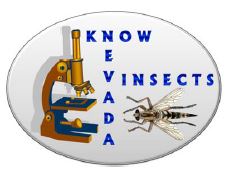
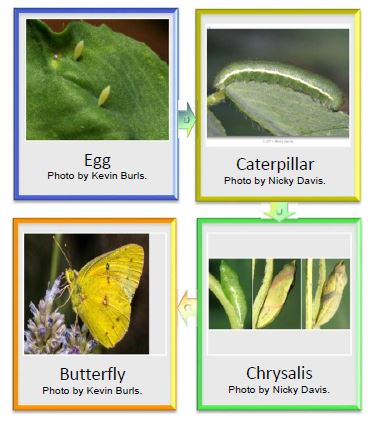
Caterpillar host plants and damage
The orange sulphur caterpillar feeds on a number of native and introduced plant species, all in the Fabaceae family. In addition to alfalfa (Medicago sativa), records for the orange sulphur in Austin and Leary’s 2008 article on the larval hostplants of butterflies in Nevada include clovers (genus Trifolium), locoweeds (Astragalus), sweet clovers (Melilotus), lupines (Lupinus) and goldenbanners (Thermopsis). Sulphur caterpillars in California seem to overwinter on plants other than alfalfa, which is likely in Nevada. Butterflies may congregate in alfalfa fields, especially as native plants die toward the end of summer.
cover photo by Kevin Burls.
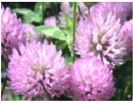
Small caterpillars damage alfalfa plants by feeding on both sides of the leaf midrib, leaving skeletonized leaves. Larger caterpillars feed from the end of whole leaves. In alfalfa fields, adults lay eggs on new growth soon after cutting, and development of larvae can be quick enough to escape successive cuttings. Abundant caterpillars, usually occurring later in summer, can cause significant crop damage. However, population sizes are usually lower than economic thresholds, and several strategies can prevent significant crop loss without the use of pesticides.
AlfalfaPhoto by Jay Davison.
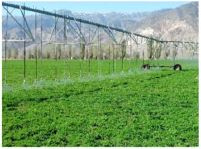
Integrated pest management
Monitoring
Alfalfa fields can be sampled for orange sulphur caterpillars by using an insect sweepnet where new growth is present. Standardized weekly samples of five sweeps at four locations can be used to estimate abundance. Caterpillars at this time should be checked for parasitism (see biological and cultural control following). Control should be used when an average of 10 or more nonparasitized caterpillars per sweep is found (UC Integrated Pest Management).
Cultural control
The best method of controlling caterpillars is by border‐strip harvesting (Carpenter et al. 1998). By leaving uncut strips of alfalfa at alternating irrigation levees or field edges, habitat is maintained for natural enemies, such as predatory and parasitic wasps (see biological control following). The strips can be mowed at the following cutting, leaving the alternate strips to continue growing. Habitat improvements, such as planting wildflowers along fence lines and waste areas, also can create habitat for beneficial insects.
Biological control
Natural enemies of orange sulphur caterpillars include a variety of solitary and social wasps, such as those in the Vespidae and Sphecidae families. The wasps use caterpillars as prey for their young, and require nectar from flowers or other sugar sources as adults. In addition to predators, many species of wasps and flies are parasitoids, laying their eggs inside the caterpillars and killing them in the process of development. One introduced species, Cotesia medicaginis, in the Braconidae family, specializes on orange sulphur caterpillars (KAC Plant Protection Quarterly 2000), but is not yet commercially available. Parasitized caterpillars are distinguished by being shiny rather than velvety on the outside, lighter than normal color, and swollen towards the rear. Swollen caterpillars can be pulled apart to reveal the white parasitoid grub. After development, the grub emerges (killing the caterpillar) to pupate, enclosing itself in a light‐colored silk cocoon, usually attached on the underside of a leaf. Wasps in the family Ichneumonidae are also caterpillar parasitoids, as are flies in the family Tachinidae. It is worth noting that many of these parasitoid species are small (1/4 to 1/2 inch) and limited in their flight range, reinforcing the importance of spacing border strips throughout fields. If populations reach economic thresholds, application of Bacillus thuringiensis (Bt) products can be effective when sprayed on young caterpillars, without harming beneficial wasps and fly adults.
References
Austin, G., and P. Leary. 2008. Larval hostplants of butterflies in Nevada. Holarctic Lepidoptera 12:1‐134.
Carpenter J., J. Knight, and W. Johnson. 1998. Integrated Pest Management of Insect Pests in Alfalfa Hay. University of Nevada Cooperative Extension Fact Sheet 98‐11.
Shapiro, A., and T. Graves. 2007. Field guide to butterflies of the San Francisco Bay an Sacramento Valley regions. California Natural History Guides Number 92. University of California Press. 345 pages
University of California Cooperative Extension. 2000. KAC Plant Protection Quarterly. Vol 10, Number 1.
University of California Integrated Pest Management. 2006. Alfalfa caterpillar and armyworm monitoring.UC ANR Publication 3430. Accessed on 11/10/15 at IPM.
Special thanks to Marcia Moffitt for the graphic design and formatting, to Cynthia Scholl for the drawing of the adult orange sulphur butterfly, to Nicky Davis for the photos of the chrysalis and caterpillar, and to Jay Davison for the photo of the alfalfa.
Burls, K. and Newton, J.
2017,
Know Nevada Insects: Orange sulphur butterfly - Colias eurytheme (Boisduval)
,
University of Nevada Cooperative Extension, Fact Sheet 17-15


